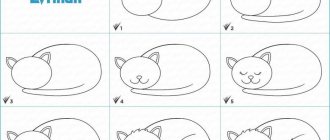Summary of an art lesson for the senior group “My favorite cat”
Potapova Elena Anatolyevna
Summary of an art lesson for the senior group “My favorite cat”
- expand knowledge about domestic animals;
- teach children to convey a familiar image of a domestic animal or cat in a drawing;
— consolidate skills in working with the end of a brush, painting skills when drawing.
2. Developmental
- develop visual skills and abilities, hand motor skills.
3. Educational
- cultivate independence and accuracy;
- cultivate a love for animals, a desire to care for them.
Preliminary work: reading poetry, fairy tales about cats, looking at illustrations, watching cartoons.
Educator: A guest came to our lesson today, and you can guess who!
Educator: Her name is Murka.
Guys, I met Murka this morning, near the kindergarten, so beautiful, she really wants to know everything about her cat history, and to look at other cats. Shall we help?
Educator: Children, which one of you have a cat at home?
-What color is she? (Children's answers)
Educator: Guys, people have many proverbs and folk beliefs about these amazing animals, let's remember them:
— The cat is washing itself and inviting guests.
- Cat out of the house - mice on the table.
— The cat hides its face in the face of frost or bad weather.
“You don’t pet a cat against its grain.”
- Cats fight, mice have fun.
- A kind word is also pleasant for a cat.
Educator: Well done, you know a lot of proverbs and folk signs!
Educator: Do you know how a cat became a pet?
For a very long time, cats have lived next to humans. In ancient times, cats were wild animals, people hunted them to get meat for food and skins. The homeland of the domestic cat is Africa.
This animal is independent, affectionate, gentle, and intelligent.
No two cats are the same. They differ from each other in the color of their fur and eyes, they have different characters. In addition, there are very fluffy ones - they are called long-haired, and there are smooth-haired ones.
The body of cats is flexible. With the help of their whiskers, they catch odors - besides, cats, and cats are excellent hunters, catch mice.
Educator: Do you guys want to draw a cat, a cat or a little kitten?
Let's take a little rest before work.
Physical school
The cat woke up this morning,
Practical part:
Educator: Now I will show you how we will draw a cat. Let's sketch the drawing with a simple pencil. Let's draw the torso and head.
Now let's finish drawing the ears, eyes, mustache, four paws and a long tail.
Choose the fur color for your animal yourself; it can be red, black, white, or gray.
Educator: Guys, where should we start coloring?
While you're drawing, give your cats a name.
Independent activity of children.
Educator: Guys, what did we talk about today?
Tell us what nicknames you came up with for them?
Lesson summary: What a great fellow you are! You all worked hard today, and you came up with very beautiful drawings - they will decorate our exhibition.
"Cat and kitten." A lesson for older children in the non-traditional drawing technique “Cat and Kitten.” The unusualness of this method lies in the fact that children are asked to paint with paints using a non-soft squirrel brush. Summary of an integrated lesson in the senior group “Cat with Kittens” Goal: To create conditions for successfully composing a story based on the painting “Cat with Kittens” using picture diagrams, continue to teach symmetrical.






